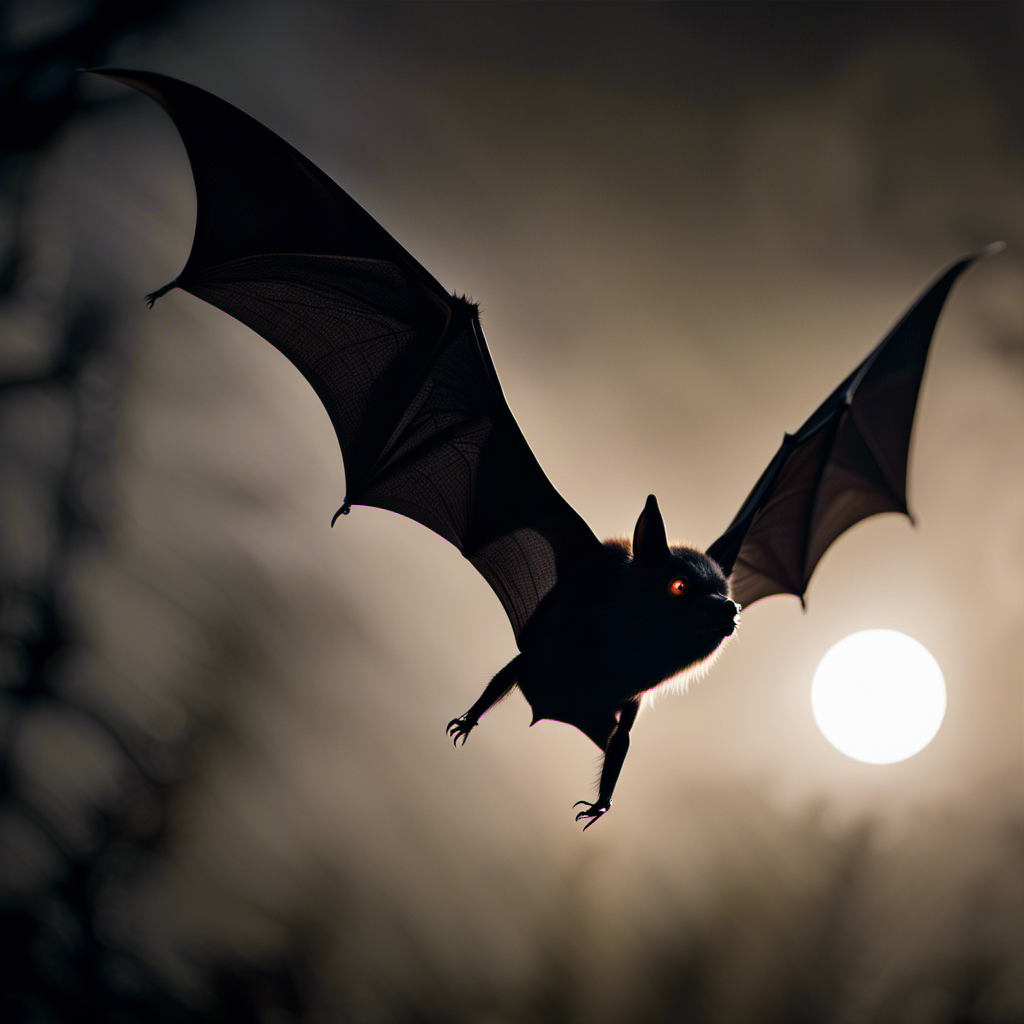While examining the way bats fly, I can’t help but wonder: Do bats truly glide when they fly?
In this scientific exploration, we will unravel the mysteries of bat wings, comparing them to those of birds and uncovering the unique flapping and gliding technique that sets bats apart.
We’ll examine the intricacies of wing morphology, the role of wing shape and flexibility, and the fascinating ways bats contribute to ecosystems.
Let us embark on this journey to dispel myths and shed light on the truth behind bat flight.
Key Takeaways
- Bats combine flapping motion with complex movements of wing joints, using both flapping and gliding techniques during flight.
- Bat wings are more flexible and have a broader surface area compared to bird wings, allowing bats to adjust wing shape and angle.
- Wing shape and flexibility are crucial to bat flight capabilities, optimizing their flight performance.
- Bats generate lift through the low pressure created on the upper surface of their wings, utilizing the physics principles of aerodynamics, lift, and drag.
The Anatomy of Bat Wings
The anatomy of bat wings allows them to glide while flying. The structure of bat wings is distinct from that of birds. Instead of feathers, bats have a thin membrane of skin stretched between elongated fingers. This membrane, known as the patagium, is highly flexible and allows bats to manipulate their wings to produce different flight maneuvers. The patagium is also supported by a framework of bones, including the elongated metacarpal and phalangeal bones. These bones provide stability and strength to the wing structure.
The aerodynamics of bat flight are also unique. Bats generate lift by creating a pressure difference between the upper and lower surfaces of their wings. This is achieved by changing the shape of their wings during flight.
As the subsequent section will explore, the wing structure and flight mechanics of bats differ significantly from those of birds.
How Bat Flight Differs from Bird Flight
When it comes to flying, you’ll notice that bats have a different flight style compared to birds. Unlike birds that rely on their feathers for lift and propulsion, bats have wings composed of a thin, flexible membrane of skin stretched between elongated finger bones. This unique wing structure allows bats to achieve flight in a distinct manner.
To better understand the differences between bird flight and bat flight, consider the following comparisons:
- Wing shape: While bird wings are typically rigid and shaped like an airfoil, bat wings are more flexible and have a broader surface area, enabling them to generate lift and maneuverability in flight.
- Wing motion: Birds primarily use the flapping motion of their wings to stay airborne, whereas bats combine flapping with complex movements of their wing joints to create different flight patterns.
- Flight speed: Birds are generally faster flyers, relying on their strong muscles to propel themselves through the air, while bats, with their unique wing structure, can perform agile maneuvers at slower speeds.
Understanding the aerodynamics of bat flight provides valuable insights into the adaptations that allow these nocturnal creatures to navigate and hunt in the dark. Now, let’s delve into the fascinating technique of flapping and gliding that bats employ during their flight.
The Flapping and Gliding Technique
To better understand bat flight, you’ll want to explore the fascinating technique of flapping and gliding.
Bats have evolved unique wing structures and aerodynamic adaptations that enable them to perform intricate aerial maneuvers. The structure of a bat’s wing consists of elongated fingers covered by a thin, flexible membrane of skin. This wing morphology allows bats to generate lift and control their flight by altering the shape of their wings.
During flapping flight, bats vigorously move their wings up and down, creating lift and thrust. This flapping motion is followed by a gliding phase, where bats extend their wings and glide through the air. The ability to alternate between flapping and gliding allows bats to conserve energy while maintaining flight stability.
This transition from flapping to gliding is a crucial aspect of bat flight, and it highlights the remarkable adaptations that bats have developed for efficient aerial locomotion.
Moving on to wing morphology and adaptations for gliding…
Wing Morphology and Adaptations for Gliding
Bats’ wings are made up of elongated fingers covered by a thin, flexible membrane of skin, allowing them to generate lift and control their flight. This unique wing structure has evolved over millions of years to suit their gliding lifestyle.
Adapted fingers: Bats have elongated fingers that form the framework of their wings. These fingers are highly flexible, enabling bats to adjust the shape and angle of their wings during flight.
Membrane structure: The thin, flexible membrane that stretches between the fingers of a bat’s wing is called the patagium. This membrane is rich in blood vessels, providing nourishment and oxygen to the wing muscles.
Wing loading: Bats have relatively low wing loading, meaning their body weight is spread out over a larger wing area. This allows them to maintain a slow and controlled flight while gliding.
Wing morphology variations: Different bat species have evolved unique wing morphologies, such as elongated wings for agile maneuverability or broad wings for increased lift during gliding.
Understanding the intricate wing structure and evolutionary adaptations of bats provides valuable insights into their remarkable gliding abilities. Transitioning to the next section, the role of wing shape and flexibility further enhances their flight capabilities.
The Role of Wing Shape and Flexibility
The role of wing shape and flexibility in bats’ flight capabilities is crucial to their ability to glide and maneuver effectively. The wing shape of bats is unique and varies among different species. This variation allows them to adapt to different habitats and ecological niches.
The shape of the wing affects the aerodynamic properties, such as lift and drag, which are essential for sustained flight. Additionally, the flexibility of the wing plays a significant role in bat flight. The ability of bats to change the shape of their wings during flight enables them to adjust their maneuverability and control. This flexibility allows bats to perform complex aerial maneuvers, such as tight turns and dives.
Understanding the importance of wing shape and flexibility in bat flight is essential for comprehending the physics behind their remarkable flying abilities. By studying these aspects, we can gain insights into the evolutionary adaptations of bats and how they have optimized their flight performance.
Understanding the Physics of Bat Flight
Understanding the physics behind bat flight allows researchers to gain insights into the evolutionary adaptations and optimized performance of these remarkable creatures.
In order to understand how bats achieve flight, it is crucial to comprehend the principles of aerodynamics, lift, and drag.
Bats have evolved unique wings that enable them to generate lift and maneuver through the air with remarkable agility. Their wings are elongated structures with a thin membrane stretched between elongated finger bones. This wing structure allows bats to generate lift by creating an area of low pressure on the upper surface of the wing, resulting in upward force.
Additionally, the shape and flexibility of their wings contribute to reducing drag, enabling bats to achieve efficient flight mechanics.
How Bats Generate Lift and Thrust
To better appreciate the physics of bat flight, imagine yourself soaring through the air with the grace and agility of these incredible creatures. Bats are able to generate lift and thrust through their unique wing structure and the application of aerodynamic principles.
Their wings are elongated and their bones are thin and flexible, allowing them to manipulate the shape of their wings during flight. This enables bats to adjust their lift and control their direction. Additionally, the membranes between the fingers of their wings provide increased surface area, enhancing lift generation.
By flapping their wings in a figure-eight motion, bats create vortices that generate lift and thrust. This combination of wing structure and aerodynamic principles allows bats to navigate the skies and catch prey with precision.
As they glide through the night, bats also rely on another remarkable ability: echolocation.
Navigating the Skies: How Bats Use Echolocation
As I navigate through the skies, I rely on echolocation to detect and locate objects around me. Bat echolocation is a remarkable adaptation that allows us to effectively communicate and navigate in the dark. Using this system, I emit high-frequency sounds and listen for the echoes that bounce back from surrounding objects. By analyzing the timing and intensity of these echoes, I can determine the distance, size, and shape of objects with great precision.
This not only helps me avoid obstacles but also allows me to locate prey and communicate with other bats. Echolocation is a vital tool for bat survival, enabling us to navigate and thrive in the darkness of night.
With this in mind, let’s explore the benefits of flapping and gliding in bat flight.
The Benefits of Flapping and Gliding
Flying through the air, bats can alternate between flapping their wings and gliding, allowing them to cover long distances and conserve energy. Gliding is a key technique employed by bats, providing them with numerous benefits. By gliding, bats can navigate through complex environments, such as dense forests or caves, with ease. It allows them to access hard-to-reach areas and find shelter or food sources more efficiently. Gliding also enables bats to conserve energy by reducing the need for continuous wing flapping. This is especially important for their survival, as bats rely on their flight abilities to catch prey and escape predators. The table below highlights the benefits of gliding and efficient flying techniques used by bats:
| Benefits of Gliding | Efficient Flying Techniques |
|---|---|
| Navigation through complex environments | Echolocation |
| Access to hard-to-reach areas | Wing morphology |
| Conservation of energy | Wing kinematics |
Understanding these strategies is crucial for the conservation and protection of bat habitats. By preserving their natural habitats and ensuring sufficient resources, we can safeguard these remarkable creatures and their unique flying abilities.
Conservation and Protecting Bat Habitats
Conserving and protecting bat habitats is essential for ensuring the survival of these remarkable creatures and their unique flying abilities. The following list highlights the key reasons why conservation efforts and habitat restoration are crucial for bat populations:
-
Bats play a vital role in maintaining ecosystem balance by controlling insect populations, which helps in agricultural pest management.
-
Protecting bat habitats preserves biodiversity, as bats are pollinators for many plants and disperse seeds, contributing to plant diversity.
-
Conservation efforts help maintain the delicate balance of cave ecosystems, which are important roosting sites for many bat species.
-
Habitat restoration initiatives provide safe spaces for bats to roost and raise their young, ensuring the long-term survival of bat populations.
The Diversity of Bat Species and Flight Abilities
Preserving bat habitats is essential for protecting the incredible diversity of bat species and their unique abilities to fly and navigate. Bats are diverse in their size, ranging from the tiny bumblebee bat to the larger flying foxes. They have adapted various flight styles, such as fast and agile flight for insect hunting or slow and steady flight for longer distances. Some species are even capable of hovering and maneuvering in tight spaces.
These flight abilities allow bats to access different food sources and habitats, contributing to the overall health of ecosystems. Additionally, bats play crucial roles in bat pollination, which is essential for the reproduction of many plant species. They also act as natural pest controllers by consuming vast numbers of insects, helping to regulate populations and reduce the need for harmful pesticides.
Understanding and conserving these remarkable creatures is vital for maintaining the balance of our natural world.
Bats as Pollinators and Pest Controllers
As we delve deeper into the world of bats, it becomes evident that their importance extends beyond their flight abilities. Bats play a crucial role in ecosystems as pollinators and natural pest controllers.
• Bat pollination is a fascinating process that occurs when bats transfer pollen from one flower to another as they feed on nectar. This mutualistic relationship ensures the reproduction of various plant species, including economically important ones such as bananas and agaves.
• Bats also contribute to natural pest control by consuming vast quantities of insects each night. This reduces the need for harmful pesticides and helps maintain a balanced ecosystem.
The intricate web of interactions between bats, plants, and insects highlights the significant ecological role that bats play. Understanding their impact is crucial for conserving these remarkable creatures and maintaining the delicate balance of our ecosystems.
Now, let’s explore in further detail the role of bats in ecosystems.
The Role of Bats in Ecosystems
Explore the fascinating role that bats play in ecosystems by delving into their impact on pollination and pest control.
Bats are crucial for the maintenance of healthy ecosystems due to their unique ecological services. They contribute to bat conservation by providing essential ecosystem services such as seed dispersal and pollination. Many plants rely on bats for pollination, and their feeding activities help to control insect populations, reducing the need for chemical pesticides.
These bat ecosystem services have a significant positive impact on the health and diversity of plant and animal communities. Understanding and protecting these services is crucial for maintaining the balance of ecosystems and promoting biodiversity.
Bat conservation efforts should focus on preserving their habitats and ensuring their continued role in providing essential ecosystem services. This understanding sets the stage for exploring bat migration patterns and long-distance travel.
Bat Migration Patterns and Long-Distance Travel
Understanding the factors that influence bat migration patterns and long-distance travel can help you appreciate the incredible journeys these animals undertake. Bat migration routes can span thousands of miles, with some species traveling from their summer breeding grounds to warmer winter habitats.
These migration patterns are influenced by a variety of factors, including food availability, mating behavior, and environmental cues. However, climate change is now affecting bat migration in significant ways. Rising temperatures and changing weather patterns can disrupt the timing and availability of resources, impacting the ability of bats to successfully migrate. Additionally, changes in habitat due to deforestation and urbanization can alter migration routes and limit suitable roosting sites.
As a result, understanding the effects of climate change on bat migration is crucial for conservation efforts.
Transitioning into the next section, it is important to debunk myths and misconceptions about bat flight.
Myths and Misconceptions about Bat Flight
After exploring the fascinating migration patterns and long-distance travel of bats, it is important to address the various myths and misconceptions surrounding bat flight.
Many people believe that bats are clumsy flyers or that they simply glide through the air. However, these assumptions are far from accurate. Bats are actually incredibly skilled and agile flyers, employing unique flight techniques that allow them to maneuver with precision and efficiency.
Debunking the myths about bat flight:
- Bats do not glide passively, but actively flap their wings to generate lift and propulsion.
- Contrary to popular belief, bats are not blind. They possess excellent vision, which enables them to navigate and locate prey even in complete darkness.
- Bats are not rodents; they belong to the order Chiroptera, which means ‘hand-wing’ in Greek, highlighting the anatomical adaptation that allows them to fly.
Understanding these facts about bat flight techniques can help dispel misconceptions and foster a greater appreciation for these remarkable creatures.
Frequently Asked Questions
How do bats use echolocation to navigate?
Bats use echolocation techniques to navigate by emitting high-frequency sounds and listening for the echoes. This allows them to create a detailed map of their surroundings, helping them avoid obstacles and find prey. The benefits of bat echolocation include enhanced hunting abilities and increased spatial awareness.
What are some misconceptions about bat flight?
Common misconceptions about bat flight include the belief that bats glide while flying. However, this is not true. Bats are capable of sustained flight and do not rely on gliding like some other animals. Debunking bat flight myths is important for a better understanding of their unique flying abilities.
Do bats have different wing shapes and flexibility?
Bats exhibit diverse wing shapes and flexibility, varying among different species. These wing adaptations enable them to perform complex aerial maneuvers, utilize echolocation for navigation, and generate lift and thrust during flight. Understanding bat flight misconceptions is crucial for appreciating their role in ecosystems.
How do bats generate lift and thrust during flight?
To generate lift, bats use the shape and flexibility of their wings to create air pressure differences. Thrust is produced by the downward stroke of their wings, propelling them forward through the air.
What is the role of bats in ecosystems?
Bats play a crucial role in ecosystems as pollinators and seed dispersers. They help in pollinating flowers and spreading seeds, contributing to the reproduction and diversity of plant species.
Conclusion
In conclusion, it is evident that bats do indeed glide while flying. Through their unique wing anatomy and adaptations, they are able to gracefully navigate the skies with a combination of flapping and gliding techniques.
Contrary to popular belief, bats are not clumsy creatures, but rather skilled aviators who play vital roles in pollination and pest control.
So, the next time you see a bat soaring through the night, remember to appreciate their impressive flight skills and the important role they play in our ecosystems.









